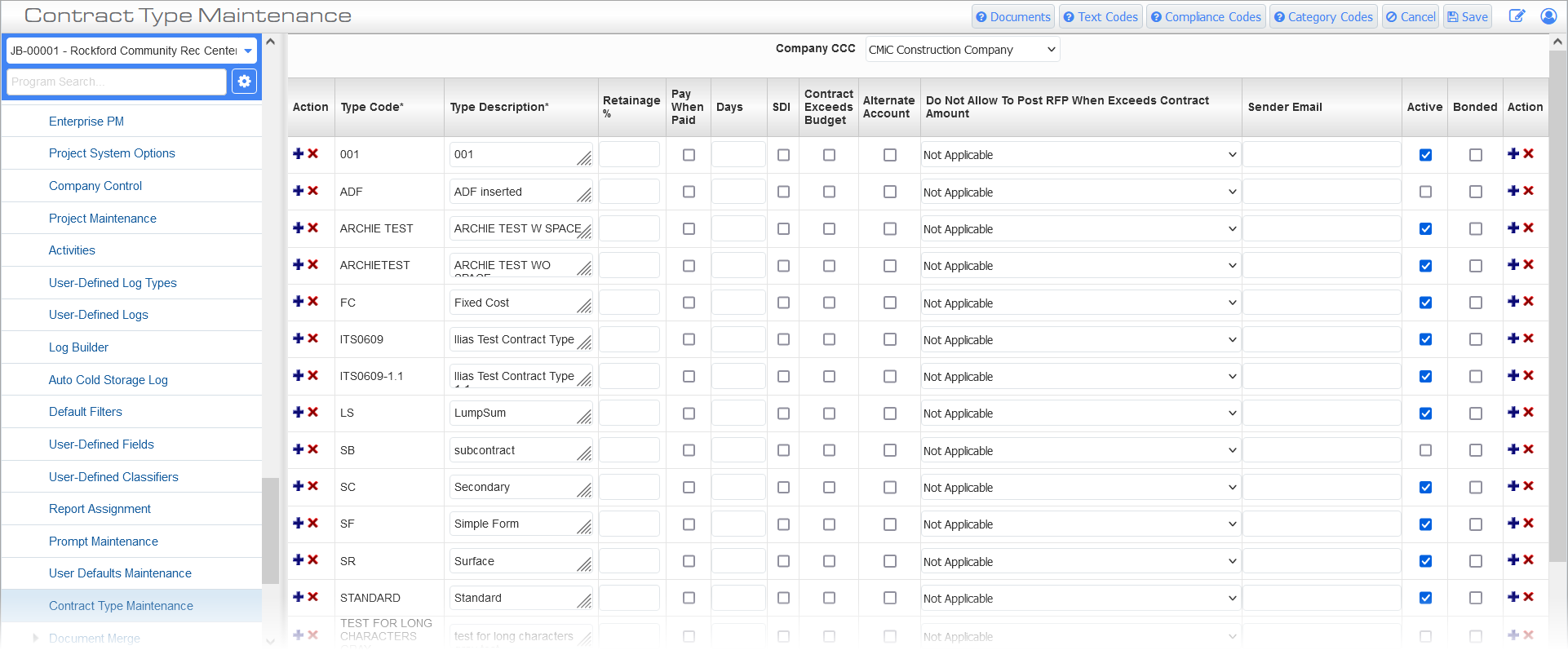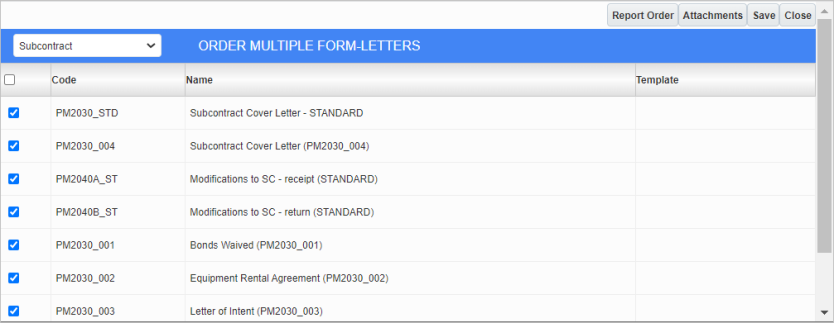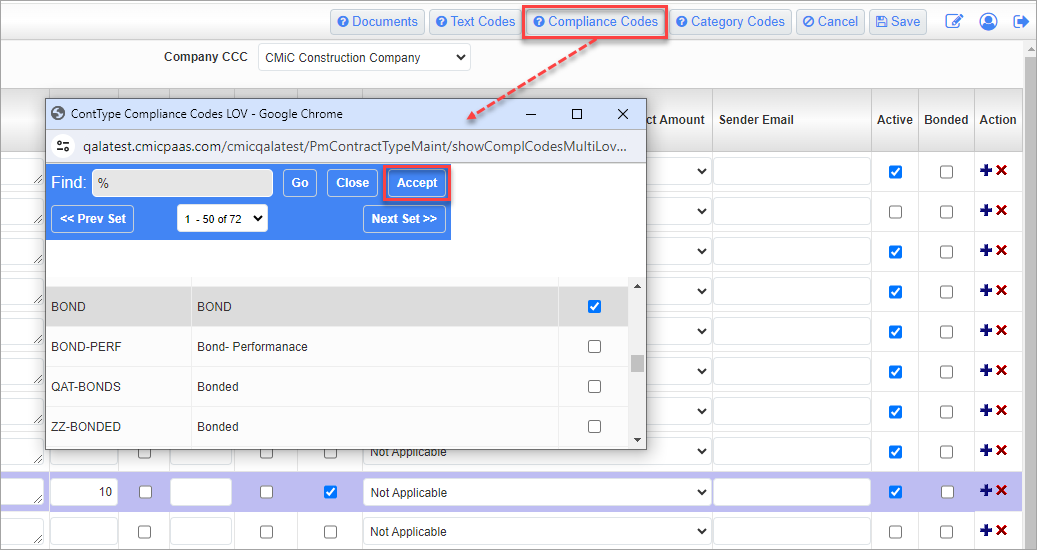
Contract Type Maintenance; standard Treeview path: CMiC Field > File Maintenance > Contract Type Maintenance
This screen is used to create contract types at the company level. For each contract type, defaults can also be defined for various subcontract fields. When creating a subcontract, a contract type can be selected in the Contract Type field to assign the type of contract being sent to the vendor.
When the 'Default SC Settings From Contract Type' checkbox is checked in the General tab of the Project System Options screen, the subcontract settings for the selected contract type will default to the subcontract being created. Company-level settings will default to new and existing projects in the Subcontract and Subcontract Change Order screens. These settings can then be further refined at the project level using the [Contract Types] button on the Project Maintenance screen if required.
NOTE: If the 'Default SC Settings From Contract Type' checkbox is unchecked in the General tab of the Project System Options screen, the subcontract standard functionality applies and compliances with ‘SC Auto Assign’ checked in the compliance screens in the Subcontract Management module will be assigned.
To get started, use the Plus icon ( ) to open a new record. The Plus icon is located in the Action column and at the bottom of the log.
) to open a new record. The Plus icon is located in the Action column and at the bottom of the log.
Company
Enter/select the company for the contract type being created.
[Documents] – Button

Select a contract type and press this button to attach existing documentation. This button allows users to select which reports are available when printing a subcontract with a specific contract type.
Press the [Attachments] button in the pop-up window to associate documents with a contract type. Any associated attachments will appear in the Attachment tab for subcontracts for that contract type.
[Text Codes] – Button
Press this button to open the Contract Types Text Code pop-up window and assign text codes to the selected contract type.
Text codes are created in the Text Code screen in the System Data module (standard Treeview path: Enterprise > System Data > Global Tables > Text Codes).
[Compliance Codes] – Button

Press this button to open the Contract Types Compliance Codes pop-up window and assign compliance codes to the selected contract type. Any codes selected at the company level will be checked at the project level. Additional codes can be checked/unchecked at the project level. Click [Accept] to save your selection.
Compliance codes are created in the Compliance Codes Maintenance screen (standard Treeview path: Enterprise > Accounts Payable > Setup > Global Tables > Compliance > Compliance Codes).
[Category Codes] – Button

Press this button to open the Contract Types Category Codes pop-up window and assign category codes. Any codes selected at the company level will be checked at the project level. Additional codes can be checked/unchecked at the project level. Click [Accept] to save your selection.
Category codes are created in the Maintain Cost Categories screen in the Job Costing module (standard Treeview path: Enterprise > Job Costing > Setup > Local Tables > Enter Category).
Action
Press the Plus icon ( ) to add a new contract type and press the Delete icon (
) to add a new contract type and press the Delete icon ( ) to remove a contract type.
) to remove a contract type.
Type Code, Type Description
Enter a code and description for the contract type.
Retainage%
Enter the retainage percentage associated with the contract type.
Pay When Paid – Checkbox
Check this box if the contract type is such that the subcontractor is only to be paid when the contractor is paid.
Days
If the ‘Pay When Paid’ box is checked, enter the number of days subcontractor pay is held after contractor payment is received.
SDI – Checkbox
This checkbox controls whether the contract type is linked with the default insurance.
Contract Exceeds Budget – Checkbox
Check this box to prevent subcontracts for this contract type from being posted if the contract amount exceeds the company budget (i.e., the amount entered in the Do Not Exceed field in the Subcontract Detail tab of the CMiC Field - Subcontracts screen).
To use this feature, the following additional settings must be enabled:
-
The ‘Default SC Settings From Contract Type’ box should be checked (standard Treeview path: CMiC Field > File Maintenance > Project System Options – General tab).
-
The 'Do Not Allow Posting if Contract Exceeds Budget' box is checked on the Subcontract Control screen (standard Treeview path: Enterprise > Subcontract Management > Local Tables > Control – Contract Defaults tab).
Alternate Account – Checkbox
Check this box to default the payment department and account for the subcontract from the Accounts Payable Control File. If the box is unchecked, then the department and account are taken from the Accounting section in the Subcontract Detail tab of the CMiC Field - Subcontracts screen.
Do Not Allow To Post RFP When Exceeds Contract Amount
This field allows for the following selections:
-
Not Applicable: If the RFP amount exceeds the contract amount then posting may still take place.
-
SOV Line Is Greater Than Assoc. Contract SOV: Posting is not allowed if any individual SOV line in the RFP has a larger amount than its corresponding contract amount.
-
Overall Request Payment Is Greater Than Contract Amount: Posting is not allowed if the overall RFP amount is greater than the contract amount.
If a situation occurs such that the selection in this field negates a request for payment, a warning is shown when the RFP is saved. If an attempt is then made to post the RFP an error message is displayed.
Sender Email
Enter the email address to default to the Sender Email address field in the Subcontract Detail tab of the CMiC Field - Subcontracts screen.
Active – Checkbox
Check this box if the contract type is active and should appear for selection in the Contract Type field on the CMiC Field - Subcontracts screen.
Bonded – Checkbox
Check this box if any subcontracts or change order of this contract are to be excluded when calculating prequalification limits for the relevant subcontractor. If a subcontract or change order has a bonded contract type no warning message will display when the single project or the aggregate project limit are exceeded.